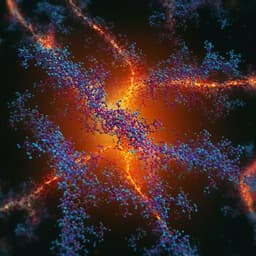
Engineering and Technology
Compositional design and phase formation capability of high-entropy rare-earth disilicates from machine learning and decision fusion
Y. Fan, Y. Bai, et al.
Discover how Yun Fan, Yuelei Bai, Qian Li, Zhiyao Lu, Dong Chen, Yuchen Liu, Wenxian Li, and Bin Liu revolutionize the design of environmental barrier coatings by integrating machine learning with the formation mechanisms of multicomponent rare-earth disilicates. Their innovative approach promises to enhance material performance with groundbreaking insights!
~3 min • Beginner • English
Introduction
Environmental barrier coatings (EBCs) protect SiC/SiC ceramic matrix composite turbine components from CMAS and water-vapor corrosion at high temperatures. Rare-earth disilicates (RE₂Si₂O₇) are promising EBC materials due to low thermal conductivity and compatible thermal expansion, especially in β and γ polymorphs. However, RE₂Si₂O₇ exhibit multiple temperature-driven polymorphs, and β–γ transitions can cause catastrophic damage in EBCs, complicating multicomponent compositional design. The central question is how to predict whether a given multicomponent composition will form a stable single-phase β- or γ-RE₂Si₂O₇. Prior ML successes in multicomponent alloys/ceramics suggest potential, but effective, interpretable ML models for β- and γ-(RE)₂Si₂O₇ remain rare. This study develops ML classifiers (SVC, ANN, RFC) and a decision-fusion strategy to identify single-phase formation in quaternary and six-component high-entropy RE disilicates, and connects feature importance to physical formation mechanisms. First-principles calculations validate selected predictions.
Literature Review
Previous ML efforts have predicted phase formation in high-entropy alloys and ceramics using ANN, RFC, and SVM, often integrating extensive descriptors or CALPHAD/DFT-informed features. For RE disilicates, configurational entropy has been proposed as a descriptor for β-phase formation but requires significant computational/experimental effort. The performance of individual RE elements towards CMAS resistance varies (inert: Yb, Lu; active: Gd, Tb, Dy; neutral: Ho, Er, Tm), and combining them can tailor corrosion behavior and phase stability. Existing reports demonstrate entropy-stabilized or high-entropy oxides and carbides, but interpretable ML models tailored to β/γ RE₂Si₂O₇ phase selection are limited, motivating a materials-oriented, explainable ML approach leveraging database-derivable descriptors.
Methodology
Data and features: Training data were collected from literature for mixed, β, and γ phases, labeled as 0, 1, and 2. Seven input features per composition were used: averages and deviations of RE³⁺ ionic radius, atomic mass, and electronegativity, plus configurational mixing entropy ΔS. Highly correlated features (Pearson |r| > 0.90) were removed; remaining features were standardized to zero mean and unit variance. Mixing entropy was computed as ΔS = −R Σ c_i ln c_i for equiatomic constituents; property averages and deviations were computed from constituent RE₂Si₂O₇ values.
Model training and evaluation: Three classifiers were built: SVC (scikit-learn, linear kernel, C = 1.5), RFC (scikit-learn, 200 trees), and ANN (both PyTorch and scikit-learn implementations, three dense hidden layers; PyTorch used Adam optimizer and cross-entropy loss). Random train/test splits with test proportions 0.15, 0.20, and 0.25 were explored; model hyperparameters were grid-searched (ANN: layers/nodes; SVC: kernel, C; RFC: number of trees, random state). Performance was evaluated via validation accuracy, confusion matrices, and ROC-AUC curves.
Decision fusion: For six-RE-principal-component compositions, k-fold cross-validation (k = 80) was used to train multiple RFC models (200 trees), then two fusion strategies combined their outputs: (1) majority voting and (2) Bayesian fusion, where per-fold validation accuracy was used as prior weights and predicted probabilities as experimental information to compute fused class probabilities. This reduced reliance on costly DFT verification for large candidate sets and improved robustness (precision ~0.875 for selected settings).
Explainability: SHAP was applied to trained RFC/SVC models to quantify global and local feature contributions, identifying key descriptors and thresholds governing single-phase formation and β/γ selection.
First-principles validation: Selected quaternary predictions were validated by DFT using VASP with PAW potentials, PBE-GGA, 520 eV plane-wave cutoff, and Γ-centered Monkhorst–Pack k-meshes (β: 2×3×3; γ: 3×2×2). Structures used SQS generated via Monte Carlo swaps on the cation sublattice; three independent SQS per composition were evaluated. Electronic convergence was 10⁻⁵ eV; ionic relaxation to forces < 0.01 eV Å⁻¹ with full cell relaxation. Phase stability was assessed by linear optimization to compute decomposition/competition enthalpy ΔH_comp relative to all competing phases, and temperature-dependent stability via mixing Gibbs free energy G_mix = H_mix − TΔS, where H_mix referenced energies of single-component RE₂Si₂O₇ with the same space group.
Key Findings
- Model performance on quaternary data (test ratio 0.15): RFC and SVC achieved validation accuracy of 1.000; ANN achieved 0.857. RFC showed superior classification quality (AUC = 1.00) compared to SVC (AUC = 0.93).
- Quaternary predictions: Among 33 (RE₀.₂₅RE′₀.₂₅Yb₀.₂₅Lu₀.₂₅)₂Si₂O₇ compositions, RFC predicted 17 single-phase materials (3 β, 14 γ). SHAP analysis identified the average RE³⁺ ionic radius and its deviation as dominant features. A β–γ boundary occurs near an average ionic radius of ~0.885 Å; single-phase formation requires small ionic-radius deviation (e.g., σ_r < ~0.066).
- DFT validation: All 17 predicted single-phase quaternary compounds exhibited negative ΔH_comp and negative G_mix, confirming thermodynamic stability above 0 K. The trend of increased thermodynamic stability with increasing average radius and radius deviation was consistent with ML analysis, though excessive values led to multiphase formation.
- Six-RE decision-fusion predictions: For 84 (RE₁/₆RE′₁/₆RE″₁/₆Gd₁/₆Yb₁/₆Lu₁/₆)₂Si₂O₇ compositions, decision fusion (Bayesian and majority voting) identified 35 single-phase materials (7 β, 28 γ). Experimental reports of γ-(Tb₁/₆Dy₁/₆Tm₁/₆Gd₁/₆Yb₁/₆Lu₁/₆)₂Si₂O₇ and γ-(Gd₁/₄Dy₁/₄Yb₁/₄Lu₁/₄)₂Si₂O₇ align with ML predictions.
- Six-RE feature thresholds from SHAP: In addition to ionic-radius descriptors, electronegativity deviation and average mass significantly influence single-phase formation. β-phase formation is favored when: (i) average RE³⁺ radius ≲ 0.900 Å (around the 0.885 Å boundary), (ii) ionic-radius deviation is small (e.g., < ~0.046 Å), (iii) electronegativity deviation is low (e.g., < ~4%), and (iv) average mass m < ~478 g·mol⁻¹; small mass deviation further aids β stability. Elemental frequency analysis indicates Y promotes β formation, whereas La and Ce tend to hinder it.
Discussion
The study addresses the key challenge of predicting single-phase β/γ formation in multicomponent RE₂Si₂O₇ by combining accurate classifiers with interpretable feature analysis and physics-based validation. High validation accuracy, perfect RFC ROC-AUC, and DFT-confirmed stability of predicted quaternaries demonstrate that database-derivable descriptors encode the essential phase-formation physics. SHAP-derived thresholds (average RE³⁺ ionic radius boundary near 0.885 Å and tight tolerances on radius deviation) rationalize β/γ selection and explain the necessity of close size-matching among RE³⁺ cations to avoid phase separation. For higher-component systems, decision fusion enhances robustness, and the emergence of electronegativity deviation and average mass as additional key factors reflects the increased complexity of multi-RE lattices. These insights provide practical, quantitative design rules for selecting RE combinations that balance phase stability with EBC performance, accelerating discovery of compositions resilient to CMAS/water-vapor environments.
Conclusion
This work establishes an interpretable, materials-oriented ML framework (SVC, ANN, RFC) with decision fusion to predict single-phase formation of multicomponent RE disilicates relevant to EBCs. For quaternary (RE₀.₂₅RE′₀.₂₅Yb₀.₂₅Lu₀.₂₅)₂Si₂O₇, RFC and SVC achieved perfect validation accuracy at optimal split, and 17 single-phase compositions (3 β, 14 γ) were predicted and confirmed thermodynamically stable by DFT. SHAP analysis revealed critical descriptors and thresholds (average RE³⁺ ionic radius near 0.885 Å boundary; small radius deviation) guiding β/γ selection. Extending to six-RE compositions, decision fusion predicted 35 single-phase materials (7 β, 28 γ), with experimental reports corroborating predictions. Additional controlling factors (electronegativity deviation, average mass) were identified for higher-component systems, leading to actionable β-phase criteria. This framework paves the way for rational compositional design within phase space and provides a foundation for future ML-driven optimization of mechanical and thermal properties in high-entropy RE disilicates. Future work could broaden datasets beyond equiatomic compositions, integrate additional processing/temperature effects, and couple property prediction with phase stability for holistic EBC design.
Limitations
- Training data were compiled from literature and focused on equiatomic compositions, potentially limiting generalizability to off-stoichiometric systems.
- While DFT validated selected quaternary predictions, most six-RE predictions relied on cross-validation and decision fusion; comprehensive experimental/DFT verification for all candidates remains outstanding.
- The approach targets β/γ phase selection; other polymorphs and temperature-driven transitions beyond the explored feature thresholds may require expanded models or additional descriptors.
- Feature definitions are derived from constituent RE₂Si₂O₇ properties; potential effects of synthesis conditions, defects, and non-equilibrium processing are not explicitly modeled.
Related Publications
Explore these studies to deepen your understanding of the subject.







